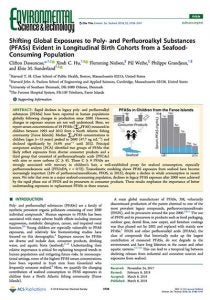 Dassuncao, Clifton, Xindi C. Hu, Flemming Nielsen, Pál Weihe, Philippe Grandjean, and Elsie M. Sunderland. “Shifting Global Exposures to Poly-and Perfluoroalkyl Substances (PFAS) Evident in Longitudinal Birth Cohorts from a Seafood-Consuming Population.” Environmental science & technology (2018).
Dassuncao, Clifton, Xindi C. Hu, Flemming Nielsen, Pál Weihe, Philippe Grandjean, and Elsie M. Sunderland. “Shifting Global Exposures to Poly-and Perfluoroalkyl Substances (PFAS) Evident in Longitudinal Birth Cohorts from a Seafood-Consuming Population.” Environmental science & technology (2018).
Declines in PFAS use in human populations have been observed since their reduced production in the years following 2000. However, trends for their remnant exposure sources remain unclear. This study reports the concentrations of 19 types of PFAS in children (age 5 to 13 years) in the Faroe Islands, a high-consumption seafood community, between 1993 and 2012. Studies have shown that children are particularly vulnerable to PFAS exposure, with aquatic biota as a primary source of exposure (among other sources like dust, consumer products, and drinking water). Researchers examined how PFAS exposure of children from populations that consume large amounts of seafood have been affected by changes in use and release of PFAS in the environment. The study’s findings highlight the global benefits from the phase out of production of PFAS and the importance to better understand exposure to PFAS and their alternatives. View article

